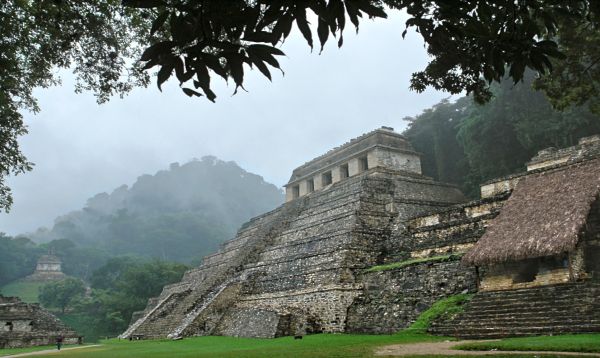Mexico City - Archaeologists at the Mayan ruin site of Palenque said Monday they have discovered an underground water tunnel built under the Temple of Inscriptions, which houses the tomb of an ancient ruler named Pakal.
Archaeologist Arnoldo Gonzalez said researchers believe the tomb and pyramid were purposely built atop a spring between AD 683 and 702. The tunnel led water from under the funeral chamber out into the broad esplanade in front of the temple, thus giving Pakal's spirit a path to the underworld.
 |
But Gonzalez said carvings on a pair of stone ear plugs found in the grave say a god "will guide the dead toward the underworld, by submerging (them) into the water so they will be received there." Pakal, in other words, didn't fly off into space; he went down the drain. "There is nothing to do with spaceships," Gonzalez said.
The tunnel, which connects to another, is made of stone and is about two feet (60 centimeters) wide and tall.
The director of archaeology for the National Institute of Anthropology and History, Pedro Sanchez Nava, said the theory makes sense in light of other pre-Hispanic peoples, such as those who lived at Teotihuacan, near Mexico City, where another water tunnel was found.
"In both cases there was a water current present," said Sanchez Nava. "There is this allegorical meaning for water ... where the cycle of life begins and ends."
The dig began in 2012, when researchers become concerned about underground anomalies detected with geo-radar under the area in front of the pyramid's steps.
Fearing a hole or geological fault that could cause the pyramid to settle or collapse, they dug at the spot - and uncovered three layers of carefully fitted stone covering the top of the tunnel.
Gonzalez said the same type of three-layered stone covering has been found in the floor of Pakal's tomb, within the pyramid.
He said there appears to be no shaft or connection between the tomb and the tunnel, but adds the conduit hasn't been fully explored yet because it is too small to crawl through. Researchers had to send a robot with a camera down to view much of the underground horizontal shaft.
Francisco Estrada-Belli, an assistant professor of archaeology at Boston University who was not involved in the dig, wrote, "I believe that building a tomb over a canal certainly does fit with the belief that water and water bodies were entrances to the underworld."
"Several cases of temples (and the associated tombs) are known to be built over natural caves that may or may not have held water," Estrada-Belli wrote.
Author Erich von Daniken suggested in his 1968 book Chariots of the Gods? that Pakal's stance in the engraving on the sarcophagus lid resembled the position of astronauts and that he appeared to be seated in a contraption with flames coming out of it and controls.
Experts say that the "flames" are in fact depictions of the Maya's "World Tree" or "Tree of Life," whose roots were believed to reach into the underworld.
Source: My San Antonio


